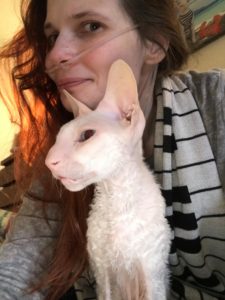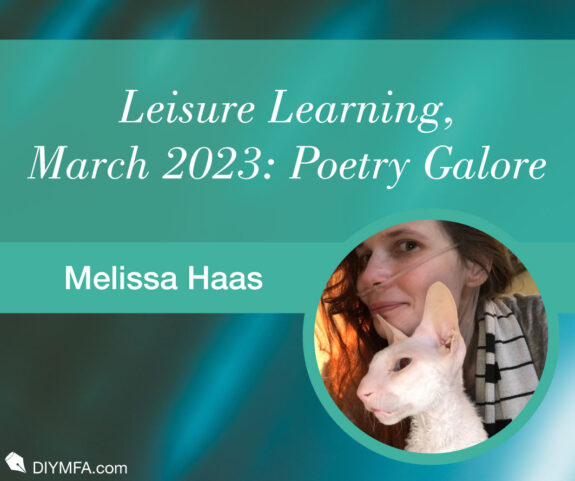Greetings, fellow word nerds! As we head into April (aka National Poetry Month), it only makes sense that this month’s Leisure Learning column should focus on the short form of the written word.
In a world where words can easily become blather, poetry offers a magnificent opportunity to return to the essence of our human experience. With poetry we are to feel the feels, to vividly bring forth what the mind has been whispering to us, to tend to the inner sanctuary.
Poetry also makes for great cross training when working on prose. If poetry has taken a backseat now that you’re working on longer forms, here are some simple ideas for getting in touch with your inner poet (other than, ahem, sitting down and actually penning a poem yourself): check out your state’s current poet laureate, elevate your dog’s life with a reading of Mary Oliver’s Dog Songs, or return to a classic and see if it speaks to you in a new way.
However you choose to experience National Poetry Month, come and word nerd out with us as we celebrate the awesomeness that occurs in April.
Americans’s Favorite Poems
In 1997, Robert Pinsky was recognized as the 39th U.S. Poet Laureate. That year, he made a contribution to the field of American poetry by creating The Favorite Poem Project, which was an open call asking anyone to write in, telling about their favorite poem and its importance.
The project received over 18,000 responses from people aged 5-97. As such, this treasure chest of Americans reading their favorite poems emerged from the endeavor. With so much astounding work held in the bosoms of so many, the best poems that didn’t get a camera crew were carried over into the anthology Americans’ Favorite Poems.
I do feel the need to mention one aspect of this project, and that is how the poems are presented. The videos were made in the late ‘90s, and feel dated in a PBS-VHS-“I’m on the cutting edge of technology, reading here from my Palm Pilot” sort of way. Still, it is the words of Shakespeare, Emerson, Dickinson, Omar Khayyam, and many others that make this collection not only timeless, but a grouping so relevant to life, it shouldn’t be missed.
***Has a poem really affected your life? If so, let everyone know on April 27, 2023 by posting with the Poem in Your Pocket Project, according to their guidelines. Should you miss my personal entry, I urge you to take a moment now and “rest in the grace of the world” with Wendell Berry’s The Peace of Wild Things.
Art Inspired by Rumi
“You dance inside my chest,
― Rumi
where no one sees you,
but sometimes I do, and that
sight becomes this art.”
Garip Ay is a cutting edge Ebru artist. Ebru art is a Turkish form of water marbling, where oily paints and pigments are mixed on the surface of the water and then transferred onto paper. Ay pushes the boundary of the art form (and creates nothing less than visual magic) by conjuring fluid masterpieces, which may never actually make it onto a piece of paper.
Here he depicts several stories by the Sufi poet Rumi, which are as elegant and lyrical as many of us know Rumi to be. The stories referenced include: The Man Who Was Able to Talk to Birds, The Man Who Found His Way by Following a Dream, and The Man Who Was Saved by a Moonbeam. This seven and a half minute mesmerizing mental swim ends with a depiction of Rumi that would make Rumi’s own spirit dance.
Calligrams and Their Creator
If you need a review or just want to learn a little more about one of poetry’s coolest forms, check out this video on the origin of calligrams, visual poems where the words are arranged into an image that is just as important as the text, as that image usually serves to complement the text.
War veteran and Parisian bohemian Guillaume Apollinaire is credited as the creator of this analog mixed media literary form and, while he is a lesser celebrated poet, he is one worth looking into. Once you have a feel for the artistic scene calligrams grew out of, take the concept into the digital era by entering your own text into Caligram.art.
Poets in the Wild
Given its short form, poetry is a great candidate to take out into the world and do on the fly. It allows for a literary approximation of busking combined with a little improv. There are at least two poets who are honing their linguistic skills (while also overcoming their fear of people), as they take their typewriters on the road and set up shop wherever they can, writing poems for donations and taking requests. See what this unique form of literary life is like, the awkward situations you may encounter and just how much cheese can mean for a person via poets Paul Wiegel and Afrose Fatima Ahmed.
The PDR Poetry Collection
If you have yet to acquaint yourself with The Public Domain Review, please take a minute to do so this month through their poetry collection. The PDR itself is a journal that aggregates public domain holdings for anyone to use. However, their greater use is to provide materials that spark important conversations by giving us perspectives with which to question contemporary society.
The materials featured on the PDR stand out because of the high quality standards they maintain. They host the “best of” materials relevant to our collective past. Moreover, this site, including the poetry section, is a feast for the eyes. They even have an uploaded version of the aforementioned Monsieur Apollinaire’s original Calligrammes.

Melissa Haas is the author and illustrator of Catula: The Misadventures of Dracula’s Cat and The Night Before Christmas (NOW WITH CATS), among others. Follow Catula’s whereabouts on Instagram @CatulaTheCat. If you’re interested in downloading free coloring pages or seeing Margaret Atwood with a blowtorch, check out more Leisure Learning related content at www.MelissaHaasCreates.com.







